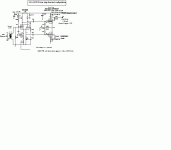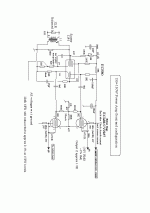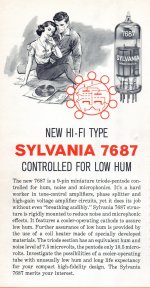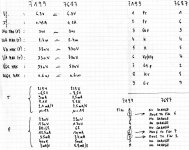The price for a famed and (lovely sounding) 7199 is getting out of hand...but the price for an ECF80 is way lower and better still they are in production. I find'em sound good and better than the 7199 Sovteks.
Anyone using a ECF80 instead of 7199 as a split-load phaseplitter ? I get good results from both pentode and triode (sim mu) using slight variation of same components but requires re-layout surgury.
I've also tried the ECF82 (triode higher mu) but sounded rather poor and harder to setup. Anyone agree?
richj
Anyone using a ECF80 instead of 7199 as a split-load phaseplitter ? I get good results from both pentode and triode (sim mu) using slight variation of same components but requires re-layout surgury.
I've also tried the ECF82 (triode higher mu) but sounded rather poor and harder to setup. Anyone agree?
richj
Hi richwalters ,
I strongly recommend the use of the cheap 6AN8 , a
med-mu triode / sharp cut-off pentode ( like 6BL8 / ECF80 )
with minor changes in resistors values , the high-quality
sound will surprise you .
Don’t forget that David Hafler , used the 6AN8 in the DYNACO
Mk II , and later he changed the 6AN8 for the 7199 , in the
STEREO 70 model , but the circuit topology remains the same.
Regards ,
Carlos
I strongly recommend the use of the cheap 6AN8 , a
med-mu triode / sharp cut-off pentode ( like 6BL8 / ECF80 )
with minor changes in resistors values , the high-quality
sound will surprise you .
Don’t forget that David Hafler , used the 6AN8 in the DYNACO
Mk II , and later he changed the 6AN8 for the 7199 , in the
STEREO 70 model , but the circuit topology remains the same.
Regards ,
Carlos
Thanks all for replies......I would add that the orig appl note on the 7199 (somewhere in Ned's triode electronics dusty files) mentioned the (wretched) sensitive g2 setup for min distortion. Indeed this is a pain for most pentodes. In every case I find g2 needs to be roughly 1/3 of anode volts (10M dig meter on pin) and with both nos 7199 and ECF82 is much more critical. The ECF80 g2 voltage can be varied much more without detriment to thd.
In my early days my books mention med/high mu triodes over 40 were not for advised for split load phasesplitter apps.......low mu triode sections make better signal handling capability esp in split load functions......nowadays yes/no ???
richj
In my early days my books mention med/high mu triodes over 40 were not for advised for split load phasesplitter apps.......low mu triode sections make better signal handling capability esp in split load functions......nowadays yes/no ???
richj
Hi all,
I have settled two ECF80 (NOS Mazda) since a few days in my Dynaco ST70 chinese clone (in place of the chinese 6F2 that looks like ECF82).
Sound is good.
I found filaments were too hots in 6F2 (2 tube alone on a 4ADC supply) with ECF80 the problem didn't occur (just inrush current & then color is nice, whilst chinese tubes were bright clear orange.)
No problems for now.
Hope this helps
I have settled two ECF80 (NOS Mazda) since a few days in my Dynaco ST70 chinese clone (in place of the chinese 6F2 that looks like ECF82).
Sound is good.
I found filaments were too hots in 6F2 (2 tube alone on a 4ADC supply) with ECF80 the problem didn't occur (just inrush current & then color is nice, whilst chinese tubes were bright clear orange.)
No problems for now.
Hope this helps
The 7199 is fast becoming a collectors item and for a few bucks the ECF80 can do a better job. I find the pentode gain sim but the tube likes a touch more current. I’ve enclosed a diag of the front end of my 150W amp which uses it. The pentode g2 is the single setup problem area and despite other configurations, the orig with discrete resistors performed the best.
Swapping the 7199 for ECF80 plus some surgury gives virtually identical stage performance, pentode 43dB and slight drop in cathode resistor value. The rest is standard amplifier building. An ECL82 pentode configured as triode self balancing voltage follower with feedback Doing the math; assume front end stage gain of 40dB the ECL82 stage gain of about 16dB. For input of 70mV will give 50V+50VRMS driving p-p parallel o/p stage at 530V will give around 140W+. Going for higher driver gain isn’t desirable with this type of circuit if one wants to keep the noise floor at –75dB down with 20dB NFB...(Vin then becomes 0.7V) Going for a 12BY7 (a brilliant tube) would only enhance the 1st stage pentode noise (10dB worse) and require even more NFB to counteract. The values shown for 1st stage snubber and interstage cap value of 8n2 are for good output transformer quality... NFB has to be increased to 36dB before hints of LF instability. This drastic increase is a good test of any tube amp.
SOme have queried the use of an ECL82 as a driver. True, this tube in triode config has rather bad curves...( I get far less thd from these than from a 6SN7 in sim circuit) and as I have several ECL82 ..I’m using ‚em. I’ve also used the med high mu triode section as a see-saw phasesplitter.....but the performance was disappointing as the two halves due to layout are some distance apart, which ruins the HF into high thd. By all merit the split load phase-splitter in one tube offers about the best for what one gets for the price.
On audio listening the split-load HF performance with the balanced voltage driver offers about the best hi-fi performance vs. simplicity and cost. Comparing this with another amp that uses the see-saw phase-splitter, the top end notes sounded quite „raspy“ especially cymbals coming through as a tizzle this due to the thd from the HF misbalance which it creates.
richj
Swapping the 7199 for ECF80 plus some surgury gives virtually identical stage performance, pentode 43dB and slight drop in cathode resistor value. The rest is standard amplifier building. An ECL82 pentode configured as triode self balancing voltage follower with feedback Doing the math; assume front end stage gain of 40dB the ECL82 stage gain of about 16dB. For input of 70mV will give 50V+50VRMS driving p-p parallel o/p stage at 530V will give around 140W+. Going for higher driver gain isn’t desirable with this type of circuit if one wants to keep the noise floor at –75dB down with 20dB NFB...(Vin then becomes 0.7V) Going for a 12BY7 (a brilliant tube) would only enhance the 1st stage pentode noise (10dB worse) and require even more NFB to counteract. The values shown for 1st stage snubber and interstage cap value of 8n2 are for good output transformer quality... NFB has to be increased to 36dB before hints of LF instability. This drastic increase is a good test of any tube amp.
SOme have queried the use of an ECL82 as a driver. True, this tube in triode config has rather bad curves...( I get far less thd from these than from a 6SN7 in sim circuit) and as I have several ECL82 ..I’m using ‚em. I’ve also used the med high mu triode section as a see-saw phasesplitter.....but the performance was disappointing as the two halves due to layout are some distance apart, which ruins the HF into high thd. By all merit the split load phase-splitter in one tube offers about the best for what one gets for the price.
On audio listening the split-load HF performance with the balanced voltage driver offers about the best hi-fi performance vs. simplicity and cost. Comparing this with another amp that uses the see-saw phase-splitter, the top end notes sounded quite „raspy“ especially cymbals coming through as a tizzle this due to the thd from the HF misbalance which it creates.
richj
Attachments
Rich,
Your work suggests that the 6BL8/ECF80 is somewhat easier to use than the 6U8/ECF82. That I will not dispute. However, think about NOS RCA 7059s. The 7059 is an inexpensive automotive variant of the 6U8, with a "12" V. heater. That's not a bad way to add RCA "chime" to the total voicing package.
Your work suggests that the 6BL8/ECF80 is somewhat easier to use than the 6U8/ECF82. That I will not dispute. However, think about NOS RCA 7059s. The 7059 is an inexpensive automotive variant of the 6U8, with a "12" V. heater. That's not a bad way to add RCA "chime" to the total voicing package.
7059 is a rare breed here in Europe.I should have mentioned in my previous mail that I don't think the split-load phasesplitt is suitable for MI apps. Distortion in MI can be wildly tolerated with and the longtail typ sounds better with most instruments using bog standard p-p. Vis-à-Vis to mention that the longtail types dont' sound so loose on hi-fi. Yes /no ??
Ironically, my first 50W p-p output tranny which I pile-wound in 1968 on a B&D drill is a perfect MI mismatched dream....with the worst spec it is the one that everyone raves using 807 tetrodes with MI. Despite amps especially made for MI, this one tops the lot for the perfect rasp with absolute simplicity. The 807's are still original KenRads.
richj
Ironically, my first 50W p-p output tranny which I pile-wound in 1968 on a B&D drill is a perfect MI mismatched dream....with the worst spec it is the one that everyone raves using 807 tetrodes with MI. Despite amps especially made for MI, this one tops the lot for the perfect rasp with absolute simplicity. The 807's are still original KenRads.
richj
I think the 6AN8 is good and have plenty of them... but I only need to move three terminals on the socket to change from 7199 to 6BL8 or 6GH8, so that's usually my choice. In most cases, the 6GH8 has worked well with the original resistor values, 6BL8 has required a little adjustment. I'd find 7199s for a SCA-35 rather than hacking the PCB. But for point-to-point amps like Bogen and Stromberg, I'll rewire the sockets.
The best substitute I know for the 7199 is Sylvania's 7687 . It's a more stable and consistent tube, has lower noise than the venerable 7199 and sounds much better too. A real upgrade in most circuits using the 7199. Unfortunately for some obscure reasons Sylvania decided to use a different pinout for their 7687 , a wrong choice who condemned this tube to oblivion... and RCA won the game with their (inferior) 7199.
Quite strangely, I've never seen a commercial Hi-Fi product using the 7687. The positive side-effect is that this tube is still available and cheap. Just remember it is NOT pin to pin compatible with the 7199 and some socket rewiring will be needed. The pentode section screen voltage may need fine adjustment for best operation, mainly in direct coupled circuits. Really worth a try.
Quite strangely, I've never seen a commercial Hi-Fi product using the 7687. The positive side-effect is that this tube is still available and cheap. Just remember it is NOT pin to pin compatible with the 7199 and some socket rewiring will be needed. The pentode section screen voltage may need fine adjustment for best operation, mainly in direct coupled circuits. Really worth a try.
Attachments
Last edited:
Tom,
What about changing to the ST 35 section using its values and the 12DW7/7059?
Kevin
12DW7/7247 won't have the gain of the 7199 - but it could be a good change if someone wanted to remove the tone controls...
I have an old Scott "laborotory reference amplifier". Its number escapes me now (272 maybe) since I am 1200 miles from home. It uses a 6BL8 to drive a pair of EL34's to about 35 WPC. It is a reasonably good sounding amp with rather large OPT's for the power level. I cloned its circuitry for several HiFi and guitar amps about 15 years ago. Some used EL34's and some used cheap Chinese KT88's. I tried 6U8's 6BL8's 6EA6's and 6GH8's in these amps. The 6BL8 sounded the best for HiFi and the 6U8 for MI.
A boutique tube seller got me some special magic tubes that did sound better than the 6BL8's in the Scott and the HiFi amps I built. I don't remember the number now, but they looked a lot like the 7687's. They had a totally different design structure. The pentode had a tall oval shaped plate. They dropped into the 6BL8 socket and sounded cleaner on the high end.
A boutique tube seller got me some special magic tubes that did sound better than the 6BL8's in the Scott and the HiFi amps I built. I don't remember the number now, but they looked a lot like the 7687's. They had a totally different design structure. The pentode had a tall oval shaped plate. They dropped into the 6BL8 socket and sounded cleaner on the high end.
I've found the pentode section of the 7199 one of the most inconsistent I have come across.....I've got several of these tubes of various vintages and makes, and not one allies with the datasheet spec. Despite the versatility of using the screen grid, I've dumped this concept and gone for pentode cum strapped triode....much more consistent with the drop in gain. Only my view of course, but my tact is to then use a stepup transformer in the front end..not a cost solution but certainly more one of performance.
- Status
- This old topic is closed. If you want to reopen this topic, contact a moderator using the "Report Post" button.
- Home
- Amplifiers
- Tubes / Valves
- ECF80 instead of 7199



